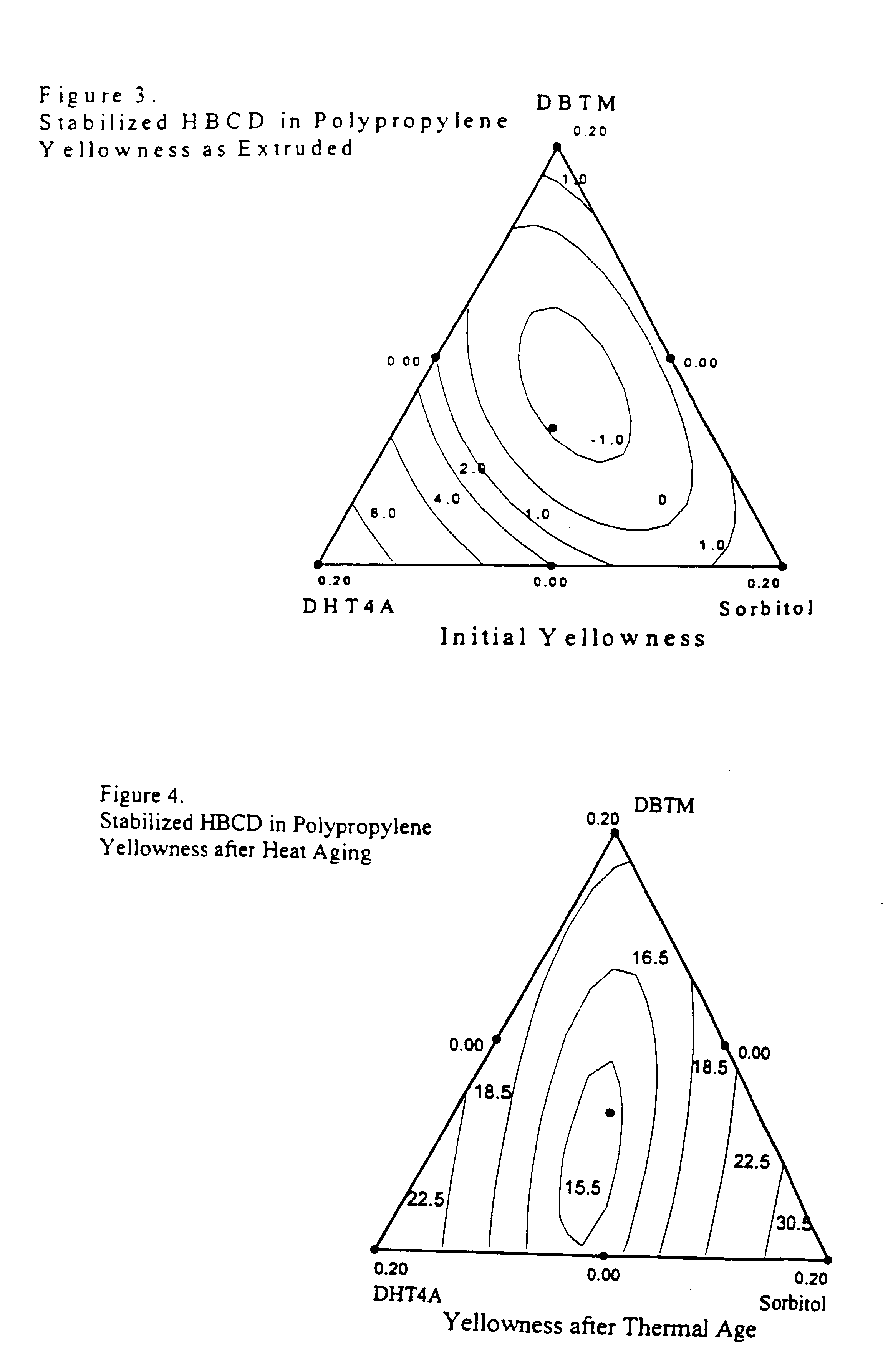Stabilizer blend for organic polymer compositions; stabilized polymer compositions and method of stabilizing polymers
a technology of organic polymer compositions and stabilizers, which is applied in the field of stabilizer blends for organic polymer compositions, can solve the problems of undesirable lowering of melt viscosity and discoloration of compositions, single component or dual component combinations, and halogenated flame retardants, particularly those containing aliphatic halogen,
- Summary
- Abstract
- Description
- Claims
- Application Information
AI Technical Summary
Benefits of technology
Problems solved by technology
Method used
Image
Examples
example 3
Each of the HIPS examples tabulated above contains 4% hexabromocyclododecane. They were compounded under the conditions shown below.
A=A commercially available product from Great Lakes Chemical Corporation (SP-75) which is a stabilized hexabromocyclododecane, typically used in polystyrene foam production.
B=A commercially available product from Great Lakes Chemical Corporation (BR-E-5300) which is a stabilized hexabromocyclododecane, typically used in glow-wire HIPS applications.
C=A ternary blend of 0.026% DHT4A+0.16% DBTM+0.014% sorbitol (percentages based on the total formulation).
The unstabilized formulation turned gray on the initial pass through the extruder; subsequent passes were not made with this material.
The multipass extrusion data demonstrate that the ternary blend (formulation S) exhibits better initial color and better color stability than two examples of commercial product currently available for this application.
example 4
Each of the HIPS examples tabulated above contains 4% hexabromocyclododecane. They were compounded under the conditions shown below.
A=A commercially available product from Great Lakes Chemical Corporation (SP-75) which is a stabilized hexabromocyclododecane, typically used in polystyrene foam production.
B=A commercially available product from Great Lakes Chemical Corporation (BR-E-5300) which is a stabilized hexabromocyclododecane and glow-wire HIPS applications.
C=A ternary blend of 0.026% by weight DHT4A=0.16% by weight DBTM=0.0141% by weight sorbitol (percentages based on the total formulation).
The multipass extrusion data demonstrate that the ternary blend (Formulation V) exhibits superior initial color and better color stability than two examples of commercial product currently available.
The following Example 5, and FIGS. 3 and 4, demonstrate the superior processing stability, heat-age stability; and color stability for halogen flame retardant-containing polypropylene.
EXAMPLE 5
E...
example 5
demonstrates the superiority of ternary blends over single- and binary-component stabilizer packages in the processing stability of flame-retarded polypropylene.
FIG. 4 shows the contours of constant yellowness index (YID) for the formulations of Example 5 that were heat aged at 150.degree. C. for 25 hours.
FIG. 4 demonstrates the superiority of ternary blends over single- and binary-component stabilizer packages in the heat age stability of flame-retarded polypropylene.
PUM
| Property | Measurement | Unit |
|---|---|---|
| temperature | aaaaa | aaaaa |
| temperatures | aaaaa | aaaaa |
| temperature | aaaaa | aaaaa |
Abstract
Description
Claims
Application Information
 Login to View More
Login to View More - R&D
- Intellectual Property
- Life Sciences
- Materials
- Tech Scout
- Unparalleled Data Quality
- Higher Quality Content
- 60% Fewer Hallucinations
Browse by: Latest US Patents, China's latest patents, Technical Efficacy Thesaurus, Application Domain, Technology Topic, Popular Technical Reports.
© 2025 PatSnap. All rights reserved.Legal|Privacy policy|Modern Slavery Act Transparency Statement|Sitemap|About US| Contact US: help@patsnap.com


